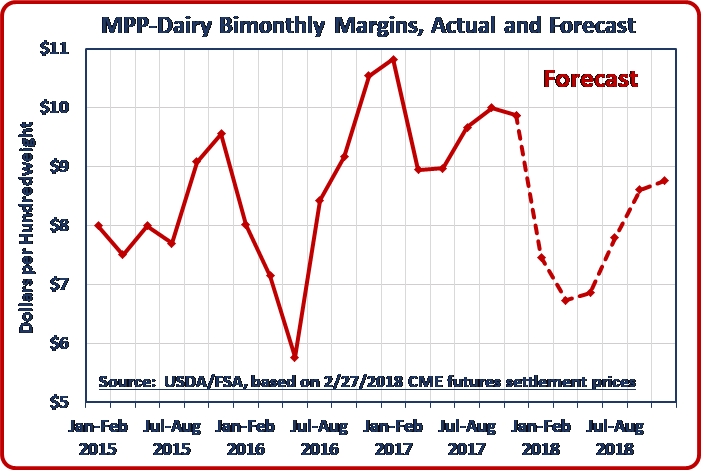MPP Forecast: March
March 1, 2018
 The monthly margin under the Margin Protection Program (MPP) for January 2018 was $8.12/cwt., $1.24 less than the December monthly margin. This was the second monthly drop in a row of at least $1.00. As with the drop from November to December, the drop from December to January was due mostly to a lower milk price. The January U.S. average all-milk price was $16.10/cwt., $1.10 below December’s all-milk price. The January MPP feed cost crept up by $0.14 from a month earlier, about the same as the rise in the MPP feed cost a month earlier. Most of the feed cost increase for January was due to higher corn and alfalfa hay prices.
The monthly margin under the Margin Protection Program (MPP) for January 2018 was $8.12/cwt., $1.24 less than the December monthly margin. This was the second monthly drop in a row of at least $1.00. As with the drop from November to December, the drop from December to January was due mostly to a lower milk price. The January U.S. average all-milk price was $16.10/cwt., $1.10 below December’s all-milk price. The January MPP feed cost crept up by $0.14 from a month earlier, about the same as the rise in the MPP feed cost a month earlier. Most of the feed cost increase for January was due to higher corn and alfalfa hay prices.
The Bipartisan Budget Act of 2018, enacted earlier this year, changed the frequency of MPP payments from bimonthly to monthly, so the MPP bimonthly margins are no longer relevant for the program. The Agriculture Department’s MPP decision tool has not yet been updated to show monthly margins; the bimonthly margin projections, based on the Feb. 27 CME dairy and grain futures settlement prices, are shown in the accompanying graph. They average $7.70/cwt. for all 12 months of 2018. If the decision tool’s projections were issued monthly, they would likely have an even lower average for 2018.
The Budget Act also significantly reduced the annual premiums to purchase MPP buy-up coverage for the first 5 million pounds of producers’ production histories. [see story above]. Coverage at the $8 margin level now costs just $0.142/cwt. per year on the first tier of production, indicating that purchasing coverage at this highest level would likely yield a significant net payment above the premium for milk covered up to the 5-million-pound limit, based on the current futures market price indications. The Budget Act also directs USDA to reopen MPP sign-up for 2018 coverage, but it is not presently known which months of this year this will occur.
USDA’s MPP margin forecasts are updated daily at online. NMPF’s Future for Dairy website offers a variety of educational resources to help farmers make better use of the program.






